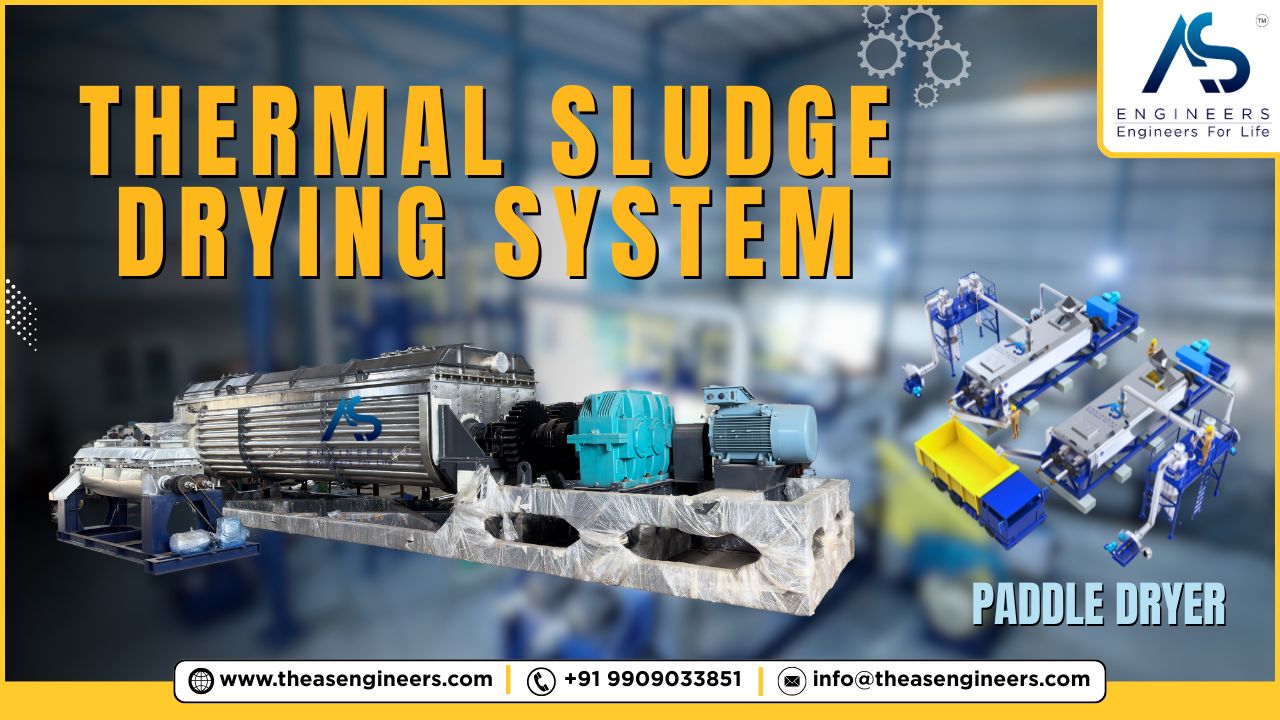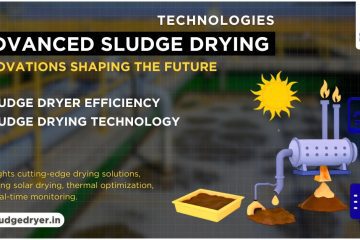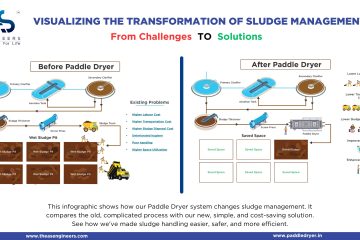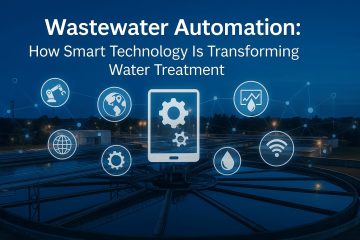Industrial facilities generate over 8 million tons of sludge annually in the United States alone, creating a mounting challenge for waste management professionals. If you’re struggling with high disposal costs, environmental compliance issues, or space constraints from wet sludge storage, a thermal sludge drying system could reduce your waste volume by up to 90% while transforming liability into opportunity. This comprehensive guide reveals how thermal drying technology works, compares leading systems, and provides actionable insights to help you select the optimal solution for your facility’s specific needs.
Table of contents
- What Is a Thermal Sludge Drying System?
- How Thermal Sludge Drying Systems Work
- Types of Thermal Sludge Drying Systems
- Key Benefits of Thermal Sludge Drying Systems
- Applications Across Industries
- Selection Criteria for Thermal Sludge Drying Systems
- Cost Analysis and Return on Investment
- Installation and Maintenance Best Practices
- Common Challenges and Solutions
- Frequently Asked Questions
- Conclusion
What Is a Thermal Sludge Drying System?
A thermal sludge drying system employs controlled heat application to remove moisture from various types of sludge, converting wet waste materials into dry, stable solids. These systems operate by exposing sludge to heated air or indirect thermal energy, evaporating water content while preserving the solid components in a more manageable form.
The technology serves multiple industries including wastewater treatment plants, food processing facilities, pharmaceutical manufacturers, and chemical production sites. Unlike traditional disposal methods that require expensive hauling of wet materials, thermal drying creates a concentrated end product with significantly reduced volume and weight.
Modern thermal sludge drying systems achieve moisture reduction from typical input levels of 75-85% down to final moisture contents of 5-15%, depending on application requirements. This dramatic transformation translates directly into cost savings through reduced transportation, disposal fees, and storage requirements.
How Thermal Sludge Drying Systems Work
The Basic Process
Thermal sludge drying operates through three fundamental phases: heat transfer, moisture evaporation, and vapor removal. The process begins when wet sludge enters the drying chamber, where it encounters heated surfaces or hot air streams. Heat energy transfers into the sludge material, raising its temperature and providing the energy necessary for water evaporation.
During the evaporation phase, moisture transforms from liquid to vapor state, separating from the solid particles. Advanced systems control this process precisely, preventing overheating that could damage organic compounds or create unwanted chemical reactions. The vapor removal phase captures and processes the generated steam, often recovering energy through condensation or directing it to emission control systems.
Heat Transfer Mechanisms
Direct Heating Systems introduce hot gases directly into contact with the sludge material. These systems typically use natural gas, propane, or biomass combustion to generate heated air streams. The hot gases flow through the sludge bed, transferring thermal energy while simultaneously carrying away evaporated moisture.
Indirect Heating Systems transfer heat through intermediary surfaces, keeping the heating medium separate from the sludge material. Steam, thermal oil, or hot water circulates through heated tubes, plates, or jackets, providing controlled thermal energy without direct contact. This approach offers better temperature control and reduces contamination risks.
Combination Systems integrate both direct and indirect heating methods, optimizing energy efficiency while maintaining process control. These hybrid approaches often achieve superior performance by leveraging the benefits of each heating method for specific process stages.
Advanced Control Features
Modern thermal sludge drying systems incorporate sophisticated control technologies that monitor temperature, moisture content, residence time, and air flow rates in real-time. Automated systems adjust heating intensity, material feed rates, and air circulation to maintain optimal drying conditions while minimizing energy consumption.
Temperature sensors throughout the system prevent hot spots and ensure uniform drying across all material. Moisture analyzers provide continuous feedback, allowing precise control over final product characteristics. These control systems also integrate safety features that prevent overheating, manage explosive atmospheres, and ensure environmental compliance.
Types of Thermal Sludge Drying Systems
Rotary Drum Dryers
Rotary drum dryers feature large cylindrical chambers that rotate continuously, tumbling sludge materials through heated air streams. The rotating action ensures consistent heat exposure while preventing material from sticking to surfaces. These systems excel at processing large volumes and handling materials with varying moisture content.
Advantages:
- High throughput capacity for large-scale operations
- Effective mixing ensures uniform drying
- Robust construction handles abrasive materials
- Proven technology with extensive track record
Disadvantages:
- Higher energy consumption compared to indirect systems
- Requires larger installation footprint
- Potential for dust generation and emissions
- Limited temperature control precision
Paddle Dryers
Paddle dryers utilize heated rotating shafts with attached paddles that move sludge through a heated trough. The paddle action provides gentle mixing while maximizing contact with heated surfaces. These systems offer excellent temperature control and energy efficiency through indirect heating methods.
Steam, thermal oil, or hot water circulates through the hollow paddle shafts and trough walls, providing consistent heat transfer without direct flame contact. The enclosed design minimizes emissions while maintaining precise control over residence time and temperature exposure.
Key Benefits:
- Superior energy efficiency through heat recovery
- Precise temperature control prevents material degradation
- Enclosed design reduces environmental impact
- Handles sticky or difficult materials effectively

Fluidized Bed Dryers
Fluidized bed dryers suspend sludge particles in upward-flowing heated air streams, creating a fluid-like behavior that ensures excellent heat and mass transfer. The fluidization process provides uniform temperature distribution while preventing particle agglomeration.
These systems work particularly well for granular or pelletized sludge materials that can maintain particle integrity during the drying process. The intense mixing action and large surface area exposure result in rapid moisture removal and consistent final product characteristics.
Thin Film Dryers
Thin film dryers spread sludge materials into thin layers across heated surfaces, maximizing heat transfer efficiency while minimizing residence time. Mechanical wipers continuously move material across the heated surface, preventing buildup while ensuring uniform exposure.
This technology excels for heat-sensitive materials that require gentle handling and precise temperature control. The short residence time and efficient heat transfer make thin film dryers ideal for materials that could degrade under prolonged heat exposure.
Key Benefits of Thermal Sludge Drying Systems
Volume and Weight Reduction
The most immediate benefit of thermal sludge drying systems involves dramatic volume and weight reduction. Typical systems reduce wet sludge volume by 75-90%, directly translating to proportional reductions in transportation costs, disposal fees, and storage requirements.
A facility generating 100 tons of wet sludge monthly could reduce this to 10-25 tons of dried material, representing potential savings of thousands of dollars in hauling and disposal costs. The concentrated nature of dried sludge also enables more efficient storage, requiring significantly less space than wet material storage systems.
Enhanced Stability and Safety
Thermal drying creates a more stable end product with reduced pathogen content and lower risk of biological activity. The heat treatment process eliminates most harmful microorganisms, creating a safer material for handling and storage.
Dried sludge generates fewer odors, reduces attraction of pests, and eliminates the leachate problems associated with wet sludge storage. This improved stability makes long-term storage feasible while reducing environmental risks and regulatory compliance challenges.
Energy Recovery Opportunities
Advanced thermal sludge drying systems incorporate energy recovery technologies that capture waste heat and reduce overall energy consumption. Heat exchangers recover thermal energy from exhaust gases, while vapor condensation systems can generate process steam or hot water for other facility operations.
Some systems achieve energy self-sufficiency by utilizing the organic content of sludge as supplemental fuel. The dried sludge material often contains sufficient calorific value to support partial combustion, offsetting external energy requirements while managing waste simultaneously.
Revenue Generation Potential
Properly dried sludge can become a valuable commodity rather than a waste disposal expense. Dried biosolids serve as effective soil amendments, fertilizers, or fuel supplements, creating potential revenue streams from materials previously considered waste.
Industries have successfully marketed dried sludge products to agriculture, landscaping, and energy sectors. The stable, concentrated nature of thermally dried materials makes transportation economical and opens markets that wet sludge cannot access due to handling limitations.
Applications Across Industries
Municipal Wastewater Treatment
Municipal wastewater treatment plants represent the largest application sector for thermal sludge drying systems. These facilities process biosolids from primary and secondary treatment processes, creating Class A biosolids suitable for unrestricted land application.
The thermal treatment process achieves pathogen reduction requirements while creating a marketable end product. Many municipalities have transformed sludge management from a cost center into a revenue-generating operation through effective thermal drying implementation.
Industrial Manufacturing
Food processing, pharmaceutical, chemical, and manufacturing facilities generate various sludge types that benefit from thermal drying treatment. Each industry faces specific challenges related to material characteristics, contamination concerns, and regulatory requirements.
Food processing sludge often contains high organic content that makes thermal drying particularly effective. Pharmaceutical facilities require careful temperature control to prevent active ingredient degradation. Chemical processing operations benefit from the ability to recover valuable materials from waste streams.
Agricultural and Food Processing
Agricultural processing facilities generate seasonal sludge volumes from operations like fruit processing, dairy production, and meat processing. Thermal drying systems provide flexibility to handle variable volumes while creating products suitable for agricultural reuse.
The seasonal nature of agricultural processing makes thermal drying particularly valuable, as dried materials can be stored during low-demand periods and marketed when conditions are favorable.
Selection Criteria for Thermal Sludge Drying Systems
Sludge Characteristics Analysis
Successful system selection begins with comprehensive sludge characterization including moisture content, organic composition, particle size distribution, and chemical properties. These characteristics directly influence system design requirements and performance expectations.
- Moisture Content: Initial and target final moisture levels determine energy requirements and system sizing. Higher initial moisture content requires more thermal energy and longer residence times.
- Organic Content: Organic materials provide potential fuel value but also influence temperature control requirements. High organic content may require lower operating temperatures to prevent combustion.
- Particle Size: Fine particles may require different handling approaches than coarse materials. Particle size affects heat transfer rates and influences system design decisions.
- Chemical Composition: Corrosive components, heavy metals, or hazardous substances influence material selection and emission control requirements.
Capacity and Throughput Requirements
System sizing must accommodate current sludge generation rates while providing capacity for future growth. Peak production periods and seasonal variations influence design specifications and operational flexibility requirements.
Calculate daily, weekly, and annual sludge volumes to determine appropriate system capacity. Consider factors like maintenance downtime, process variations, and storage capacity when establishing throughput requirements.
Energy Considerations
Energy costs represent a significant portion of thermal drying operational expenses. Evaluate available energy sources including natural gas, electricity, steam, and waste heat recovery opportunities.
Compare energy efficiency ratings between different system types and manufacturers. Consider heat recovery systems, insulation quality, and process optimization features that reduce overall energy consumption.
Environmental and Regulatory Compliance
Thermal sludge drying systems must comply with air emission regulations, waste management requirements, and local zoning restrictions. Evaluate emission control capabilities including dust collection, odor control, and air pollution prevention features.
Consider permit requirements, environmental impact assessments, and community relations factors that could influence project approval and ongoing operations.
Cost Analysis and Return on Investment
Capital Investment Components
Thermal sludge drying system costs vary significantly based on capacity, technology type, and site-specific requirements. Typical installations range from $500,000 for small systems to over $10 million for large municipal facilities.
- Equipment Costs: The drying system itself typically represents 40-60% of total project cost, including the dryer, auxiliary equipment, and control systems.
- Installation and Construction: Site preparation, utilities, buildings, and installation labor add 25-35% to equipment costs.
- Engineering and Permits: Design engineering, permitting, and project management contribute 10-15% of total investment.
- Contingency and Start-up: Budget 10-20% additional for unforeseen costs and commissioning activities.
Operating Cost Considerations
- Energy Costs: Thermal energy represents the largest operating expense, typically $20-50 per ton of water removed depending on fuel costs and system efficiency.
- Labor: Automated systems require minimal operator attention, with labor costs ranging from $5-15 per ton of processed sludge.
- Maintenance: Planned maintenance, spare parts, and periodic overhauls contribute $10-25 per ton of processed material annually.
- Utilities: Electrical power, water, and compressed air add $3-8 per ton to operating costs.
Financial Benefits Calculation
- Disposal Cost Savings: The primary financial benefit comes from reduced disposal costs. If current disposal costs $100 per ton for wet sludge, volume reduction to 20% of original creates $80 per ton in savings.
- Transportation Savings: Reduced volume and weight proportionally reduce hauling costs, often representing 30-50% of total disposal expenses.
- Revenue Opportunities: Dried sludge sales can generate $20-100 per ton depending on market conditions and product quality.
- Payback Period: Well-designed systems typically achieve payback periods of 3-7 years depending on sludge volumes, disposal costs, and energy prices.
Installation and Maintenance Best Practices
Pre-Installation Planning
Successful thermal sludge drying system installation requires thorough planning addressing site conditions, utilities, and operational integration. Conduct comprehensive site surveys including soil conditions, utility availability, and environmental constraints.
Develop detailed project schedules coordinating equipment delivery, construction activities, and facility integration requirements. Plan for temporary sludge management during construction and commissioning phases.
Commissioning and Start-up
Professional commissioning ensures optimal system performance while identifying potential issues before full-scale operation. Commissioning activities include equipment testing, control system calibration, and performance verification under various operating conditions.
Conduct comprehensive operator training covering normal operations, maintenance procedures, troubleshooting, and emergency response protocols. Document all system parameters and establish baseline performance metrics for ongoing optimization.
Preventive Maintenance Programs
Implement structured preventive maintenance programs addressing critical system components including heating elements, motors, conveyors, and control systems. Regular maintenance prevents costly breakdowns while maintaining optimal energy efficiency.
- Daily Inspections: Monitor operating parameters, check for unusual noises or vibrations, and verify control system functions.
- Weekly Maintenance: Lubricate moving parts, inspect wear components, and clean sensors and instrumentation.
- Monthly Activities: Perform detailed inspections of heating systems, emission control equipment, and safety devices.
- Annual Overhauls: Schedule major maintenance including component replacement, system calibration, and performance optimization.
Performance Monitoring and Optimization
Establish key performance indicators tracking energy consumption, throughput rates, final moisture content, and equipment availability. Regular performance analysis identifies optimization opportunities and prevents gradual efficiency degradation.
Monitor trends in energy consumption per unit of processed sludge to identify efficiency changes over time. Track maintenance costs and equipment reliability to optimize maintenance schedules and replacement planning.
Common Challenges and Solutions
Material Handling Issues
Sludge materials can present handling challenges including sticking, bridging, and uneven flow characteristics. These issues affect system performance and require specific design considerations or operational modifications.
- Sticky Materials: Adjust operating temperatures, residence times, or pre-treatment processes to improve material flow characteristics.
- Variable Consistency: Implement mixing systems or storage equalization to provide consistent feed characteristics to the drying system.
- Bridging and Plugging: Design adequate clearances, install bridge breakers, or modify material feed systems to prevent flow restrictions.
Emission Control Challenges
Thermal drying processes can generate odors, dust, and potentially hazardous emissions requiring effective control systems. Proper system design and operation maintains environmental compliance while minimizing community impact.
- Odor Control: Install appropriate ventilation systems, thermal oxidizers, or biofilters to eliminate objectionable odors before emission.
- Dust Management: Implement effective dust collection systems including baghouses, cyclones, or wet scrubbing systems.
- Volatile Organic Compounds: Install thermal oxidation or carbon adsorption systems to control VOC emissions where required.
Energy Efficiency Optimization
High energy costs can significantly impact thermal drying economics, making efficiency optimization crucial for successful operations. Multiple strategies can reduce energy consumption while maintaining process performance.
- Heat Recovery: Install heat exchangers to recover thermal energy from exhaust gases and vapor condensation.
- Insulation Improvements: Upgrade insulation on hot surfaces to minimize heat losses and reduce energy requirements.
- Process Integration: Utilize waste heat from other facility operations or generate steam for other processes using thermal drying waste heat.
Frequently Asked Questions
- What is the typical moisture reduction achieved by thermal sludge drying systems? Thermal sludge drying systems typically reduce moisture content from 75-85% down to 5-15%, achieving 75-90% volume reduction. The exact performance depends on input material characteristics, system design, and operational parameters.
- How much energy does a thermal sludge drying system consume?
Energy consumption varies significantly based on system type and moisture removal requirements, typically ranging from 2,500-4,000 BTU per pound of water evaporated. Modern systems with heat recovery can achieve the lower end of this range. - What maintenance is required for thermal sludge drying systems?
Regular maintenance includes daily operational checks, weekly lubrication and cleaning, monthly detailed inspections, and annual major overhauls. Automated systems require minimal daily operator attention but benefit from structured preventive maintenance programs. - Can thermal drying systems handle different types of sludge?
Yes, thermal drying systems can process various sludge types including municipal biosolids, industrial waste, food processing residuals, and pharmaceutical wastes. System design must match specific material characteristics and processing requirements. - What are the environmental benefits of thermal sludge drying?
Thermal drying reduces landfill disposal volumes, eliminates pathogen concerns, minimizes odor generation, and can create beneficial end products. The process also enables resource recovery and reduces transportation-related environmental impacts.
Conclusion
Thermal sludge drying systems represent a proven, cost-effective solution for industrial waste management challenges facing facilities across multiple sectors. The technology transforms wet sludge liabilities into manageable, potentially valuable resources while reducing disposal costs by 60-80% through dramatic volume reduction.
The key to successful implementation lies in careful system selection based on comprehensive sludge characterization, accurate capacity planning, and thorough evaluation of site-specific requirements. Modern thermal sludge drying systems offer sophisticated control capabilities, energy recovery opportunities, and reliable performance that delivers measurable return on investment within 3-7 years for most applications.
Whether you’re managing municipal biosolids, industrial process waste, or food processing residuals, thermal drying technology provides the flexibility and efficiency needed to transform waste management from an operational burden into a strategic advantage. The combination of regulatory compliance, cost reduction, and revenue generation potential makes thermal sludge drying systems an essential consideration for any facility serious about optimizing their waste management operations.
Ready to explore how a thermal sludge drying system could benefit your facility? Contact our technical team for a customized feasibility analysis and discover the potential savings and operational improvements waiting in your current waste stream.




